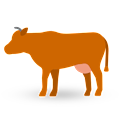Flanke
(Schliem, Rindfleisch)
In German butchery, flanke refers to a specific cut of beef taken from the abdominal muscles of the cow. Situated below the loin and rib and spanning the belly area, flanke is a long, flat cut. It plays a crucial role in the cow's locomotion and thus has a well-developed muscle structure.
Due to its location on the cow and the constant activity of this muscle, flanke tends to be lean and possesses a distinct grain pattern. While it's flavorful due to its well-exercised nature, it's also inherently tough, with pronounced muscle fibers.
Flanke's grainy texture lends itself well to specific culinary applications. In German cuisine, it's not as prominently featured as in some other cultures, like in Latin American cuisines where it's the chosen cut for dishes like carne asada. Read more
Nonetheless, it's still valued for dishes requiring longer cooking times, like braising, or when meat is thinly sliced against the grain. Marinating the flanke can introduce additional flavors and help tenderize the meat, especially if acidic components are used.
Grilling or broiling after marination is common. If cooking whole, it's essential to slice it against the grain to maximize tenderness. Slow-cooking methods, like braising, can also break down its tougher fibers, rendering the meat more tender and succulent.
The beefy flavor of the flanke pairs excellently with bold marinades and spices. Ingredients like garlic, chili, citrus, and vinegar can enhance its natural taste. In stews or braised dishes, aromatic vegetables, robust herbs, and flavorful liquids (like beer, wine, or beef broth) further complement flanke's characteristics.



